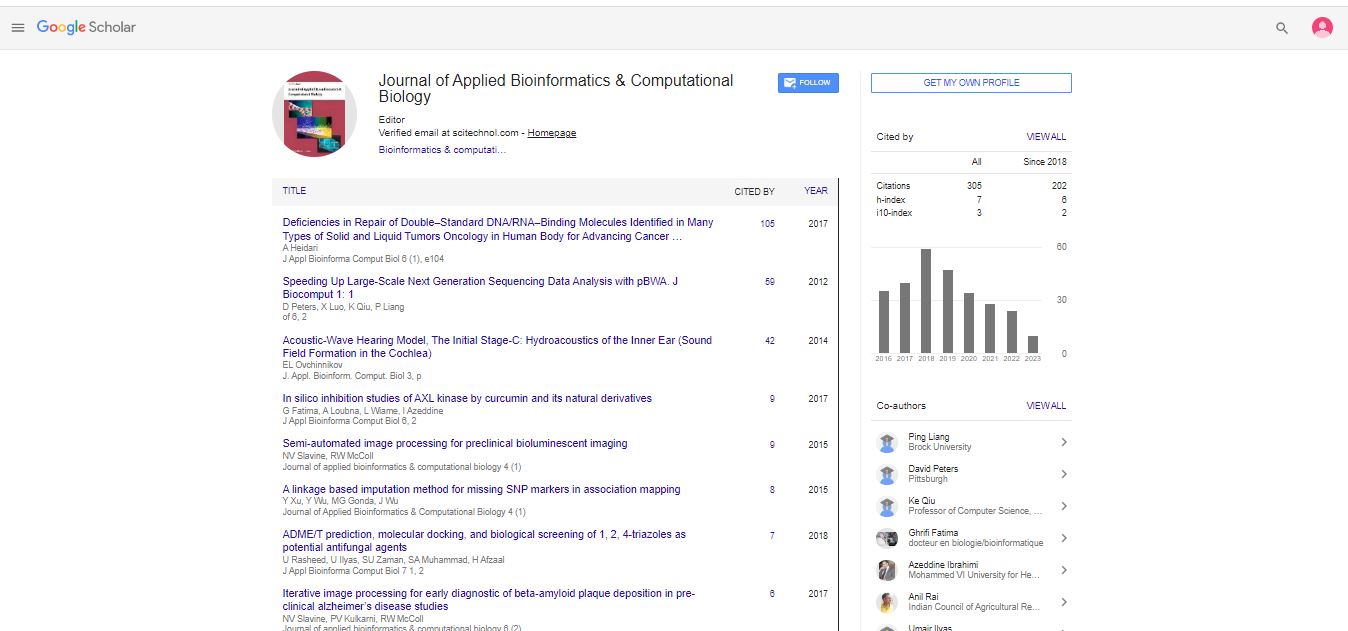Perspective, Vol: 14 Issue: 1
Cracking the Mysterious Protein Prognosis as the Key to Comprehending Complicated Structures
Yan Shen*
Department of Biotechnology, Saveetha University, Tamil Nadu, India
*Corresponding Author: Yan Shen,
Department of Biotechnology, Saveetha University, Tamil Nadu, India
E-mail: sheny29@gmail.com
Received date: 20 February, 2024, Manuscript No. JABCB-24-127924;
Editor assigned date: 22 February, 2024, PreQC No. JABCB-24-127924 (PQ);
Reviewed date: 04 March, 2024, QC No. JABCB-24-127924;
Revised date: 22 April, 2025, Manuscript No. JABCB-24-127924 (R);
Published date: 29 April, 2025, DOI: 10.4172/2329-9533.1000297
Citation: Shen Y (2025) Cracking the Mysterious Protein Prognosis as the Key to Comprehending Complicated Structures. J Appl Bioinforma Comput Biol 14:1.
Introduction
Proteins, the workhorses of biological systems, are intricately folded molecules responsible for a plethora of functions within living organisms. From catalyzing biochemical reactions to providing structural support, proteins play a fundamental role in life as we know it. Understanding their complex structures is crucial for deciphering their functions and unlocking insights into various biological processes. Protein prediction emerges as a powerful methodological approach, offering a window into the intricate world of protein structure and function.At its core, protein prediction utilizes computational algorithms and mathematical models to forecast the Three-Dimensional (3D) structure of proteins based on their amino acid sequences. This methodology has revolutionized the field of structural biology, enabling researchers to explore protein structures with unprecedented precision and efficiency. By predicting the spatial arrangement of atoms within a protein, scientists can gain valuable insights into its biochemical properties, interactions, and potential roles in cellular processes.
Description
One of the primary challenges in structural biology is the determination of protein structures experimentally. Traditional methods such as X-ray crystallography and Nuclear Magnetic Resonance (NMR) spectroscopy are powerful but often timeconsuming, labor-intensive, and costly. Moreover, some proteins may prove recalcitrant to crystallization or NMR analysis, limiting the applicability of these techniques. Protein prediction offers a complementary approach, providing rapid and cost-effective structural insights, particularly for proteins with elusive experimental structures.
The foundation of protein prediction lies in the relationship between a protein's amino acid sequence and its native 3D structure, known as the sequence-structure relationship. Through decades of research and development, computational biologists have devised a myriad of prediction algorithms and software tools that leverage this relationship to infer protein structures. These methods encompass diverse strategies, including homology modeling, ab initio modeling, and hybrid approaches that combine multiple prediction techniques.
Homology modeling, also known as comparative modeling, exploits the principle of evolutionary conservation to predict the structure of a target protein based on the known structure of a homologous protein. By identifying evolutionary relationships and aligning sequences, homology modeling can accurately predict the structure of proteins sharing significant sequence similarity with a known template.
In contrast, ab initio modeling, or de novo protein structure prediction, aims to predict protein structures from scratch, without relying on homologous templates. This approach involves predicting the energetically favorable conformation of a protein by exploring the vast conformational space of its amino acid sequence. While ab initio modeling faces significant challenges due to the complexity of protein folding, advances in algorithm development and computational resources have led to notable progress in this field.
Hybrid methods combine the strengths of homology modeling and ab initio modeling to improve prediction accuracy and coverage. By integrating information from homologous templates and ab initio simulations, these approaches offer a versatile toolkit for protein structure prediction, particularly for challenging cases where homologous templates are unavailable or unreliable.
Validation and refinement are critical steps in the protein prediction process to assess the quality and reliability of predicted structures. Various metrics and bench-marks, such as Root Mean Square Deviation (RMSD) and Global Distance Test (GDT), are employed to evaluate the similarity between predicted and experimentally determined structures. Additionally, molecular dynamics simulations and energy minimization algorithms can be utilized to refine predicted structures and enhance their accuracy.
The applications of protein prediction are diverse and far-reaching, spanning fields such as drug discovery, enzyme engineering, and protein design. In drug discovery, accurate prediction of protein structures facilitates the rational design of therapeutic agents targeting specific protein targets. Enzyme engineering benefits from the ability to predict and modify protein structures to enhance enzymatic activity, substrate specificity, and stability. Furthermore, protein design endeavors leverage prediction techniques to engineer novel proteins with tailored functions for biotechnological and biomedical applications.
Despite significant advancements, challenges persist in the field of protein prediction, including the accurate prediction of protein-protein interactions, post-translational modifications, and conformational dynamics. Additionally, the integration of experimental data, such as cryo-electron microscopy and cross-linking mass spectrometry, with computational predictions presents exciting opportunities to enhance the accuracy and scope of protein structure prediction.
 Spanish
Spanish  Chinese
Chinese  Russian
Russian  German
German  French
French  Japanese
Japanese  Portuguese
Portuguese  Hindi
Hindi 
